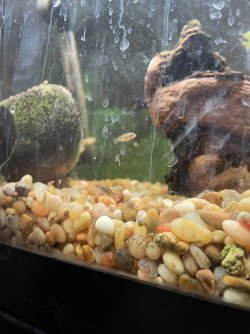kribensis12
I know where you live
I can't believe I'm writing this. An unknown killer has again killed my fish and I'm getting ready to throw in the towel on my breeding operations. Here is what just happened and at the end of this post, I'll share links to this EXACT same thing occurring to other species of fish in other tanks.
Tank Info:
20 Gallons, established for 1 year.
Inhabitants: Roughly 20 1/2 inch long fry - my first batch of F1 Pelvicachromis Kribensis "Moliwe"
Temp: 83F
Water Quality: pH 7.2, kH 80, gH 100, Ammonia: 0, Nitrite: 0, Nitrate <10
NO recent changes/additions to the tank.
Situation: I left on a 2 day family vacation with my kiddos. When I left, the fry were vigorously eating and swimming around, living their best life. I came home today to a mortality rate of 80% and climbing.
Symptoms: None - except that those that are left alive seem sluggish and the tips of their fins are foggy white (excess slime coat)? They are not gasping for breath, itching or anything else.
I immediately did a 50% water change.
Backstory: This exact same thing has occurred to me two times before - once in a tank full of Ram Cichlid fry (3 months ago) and once to a breeding pair of cockatoo apistogramma (1 year ago). Both times I was unable to determine a concrete source for the issue. I was previously making my own RO water at home for these aquariums (our local water is as hard as concrete) and it was thought that possibly that somehow the resins in the filter contaminated the water and caused the fish to be poisoned. Since I didn't have a better theory, I've begun buying pure RO water and using that in ALL of my tanks and supplementing with rain water when we get a good rain.
I do the EXACT same maintenance schedule for all of my aquariums and I have other aquariums running right now with healthy fish. A 20 long house 15 cockatoo aristo (grow out), a 20 long with the breeding pair of Moliwe and 1 month old fry and a 10g with a pair of cockatoo aristo and their fry (looking to get them in a larger tank soon). These fish have all had the same care taken of them - but they aren't dropping like flies.
Here are the previous scenarios:
Killer Tank Strikes Again
Poisoned?
I have lost a lot of money and time due to whatever is the cause for these deaths. Please someone help me before I give up!
Tank Info:
20 Gallons, established for 1 year.
Inhabitants: Roughly 20 1/2 inch long fry - my first batch of F1 Pelvicachromis Kribensis "Moliwe"
Temp: 83F
Water Quality: pH 7.2, kH 80, gH 100, Ammonia: 0, Nitrite: 0, Nitrate <10
NO recent changes/additions to the tank.
Situation: I left on a 2 day family vacation with my kiddos. When I left, the fry were vigorously eating and swimming around, living their best life. I came home today to a mortality rate of 80% and climbing.
Symptoms: None - except that those that are left alive seem sluggish and the tips of their fins are foggy white (excess slime coat)? They are not gasping for breath, itching or anything else.
I immediately did a 50% water change.
Backstory: This exact same thing has occurred to me two times before - once in a tank full of Ram Cichlid fry (3 months ago) and once to a breeding pair of cockatoo apistogramma (1 year ago). Both times I was unable to determine a concrete source for the issue. I was previously making my own RO water at home for these aquariums (our local water is as hard as concrete) and it was thought that possibly that somehow the resins in the filter contaminated the water and caused the fish to be poisoned. Since I didn't have a better theory, I've begun buying pure RO water and using that in ALL of my tanks and supplementing with rain water when we get a good rain.
I do the EXACT same maintenance schedule for all of my aquariums and I have other aquariums running right now with healthy fish. A 20 long house 15 cockatoo aristo (grow out), a 20 long with the breeding pair of Moliwe and 1 month old fry and a 10g with a pair of cockatoo aristo and their fry (looking to get them in a larger tank soon). These fish have all had the same care taken of them - but they aren't dropping like flies.
Here are the previous scenarios:
Killer Tank Strikes Again
Poisoned?
I have lost a lot of money and time due to whatever is the cause for these deaths. Please someone help me before I give up!





